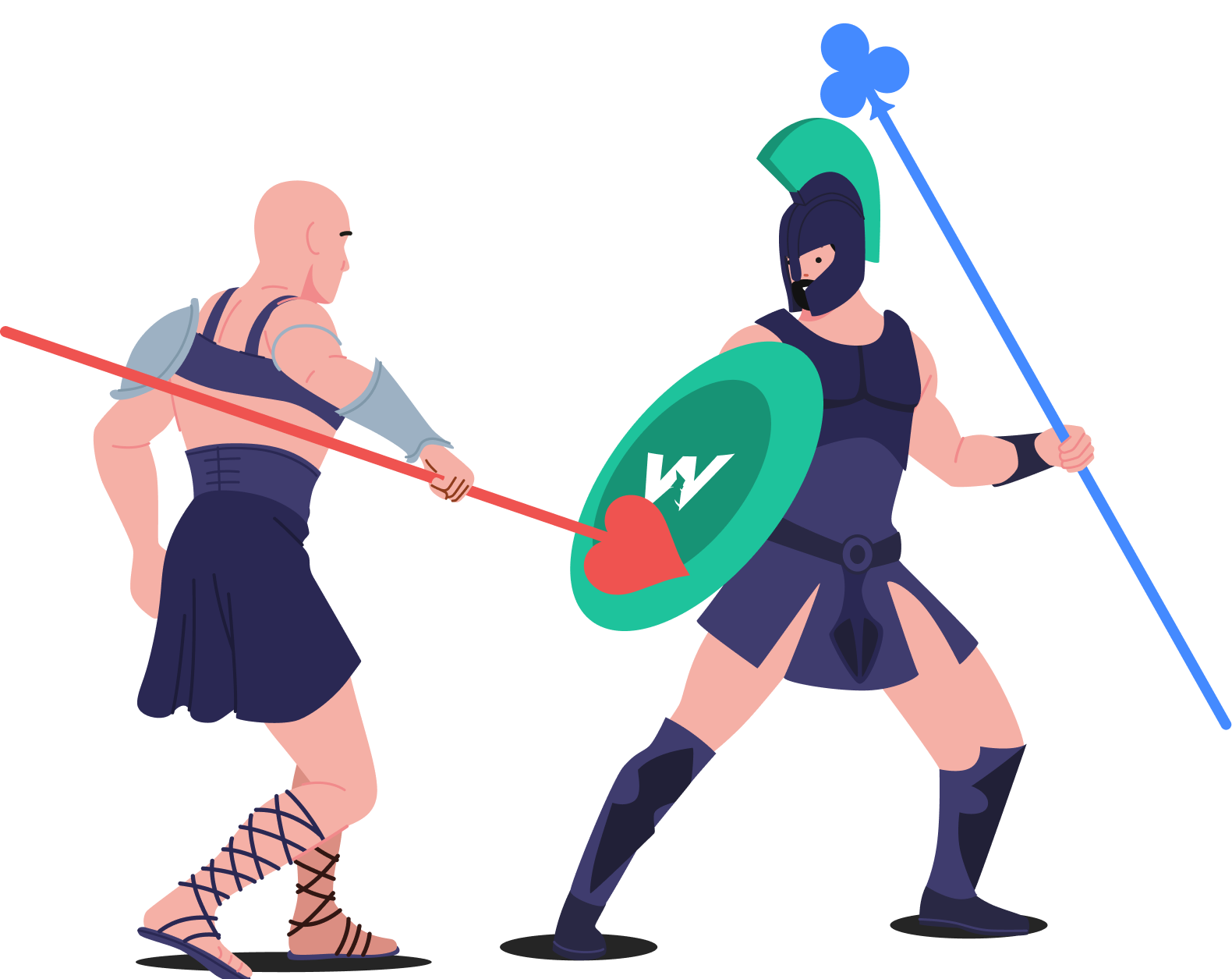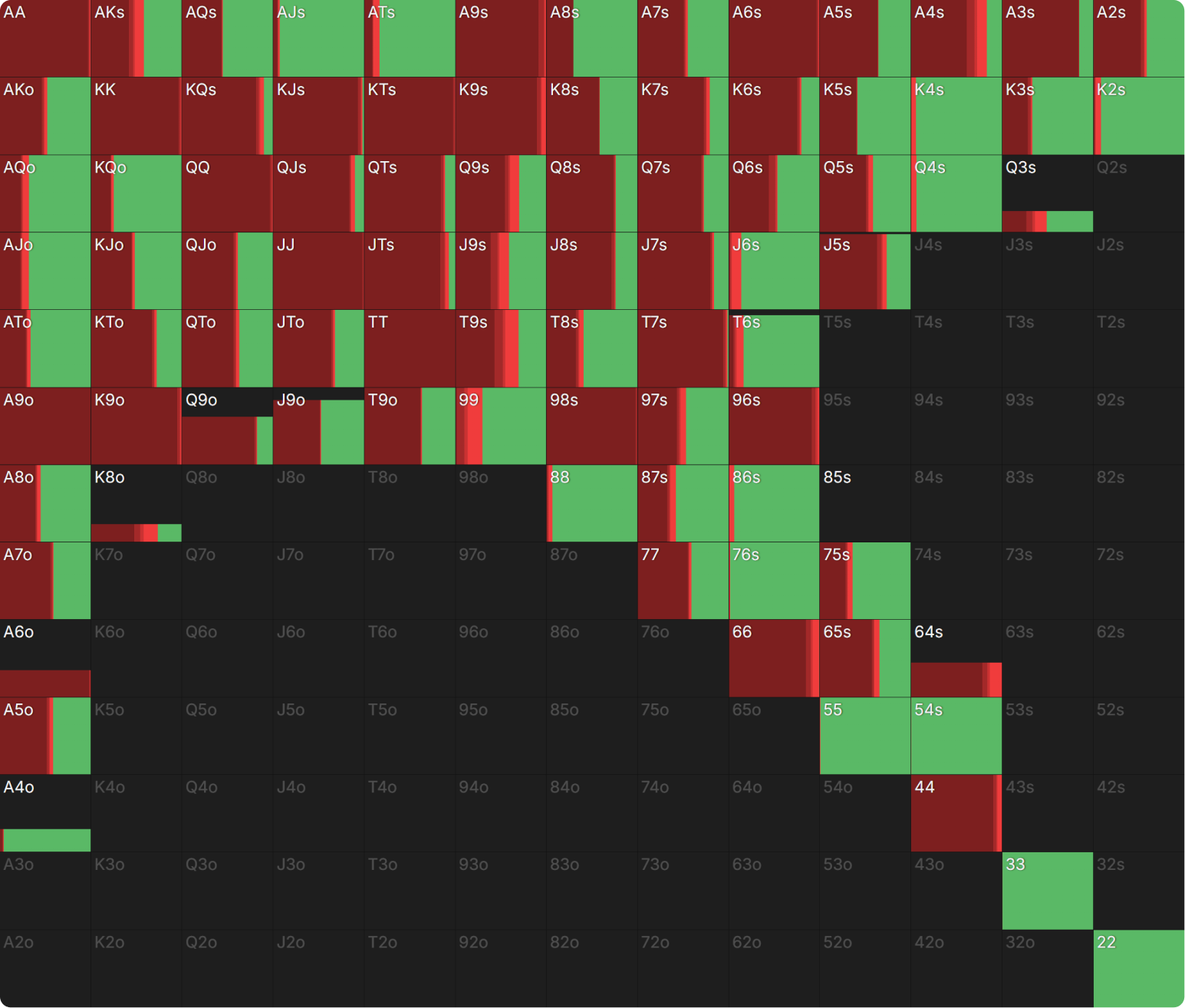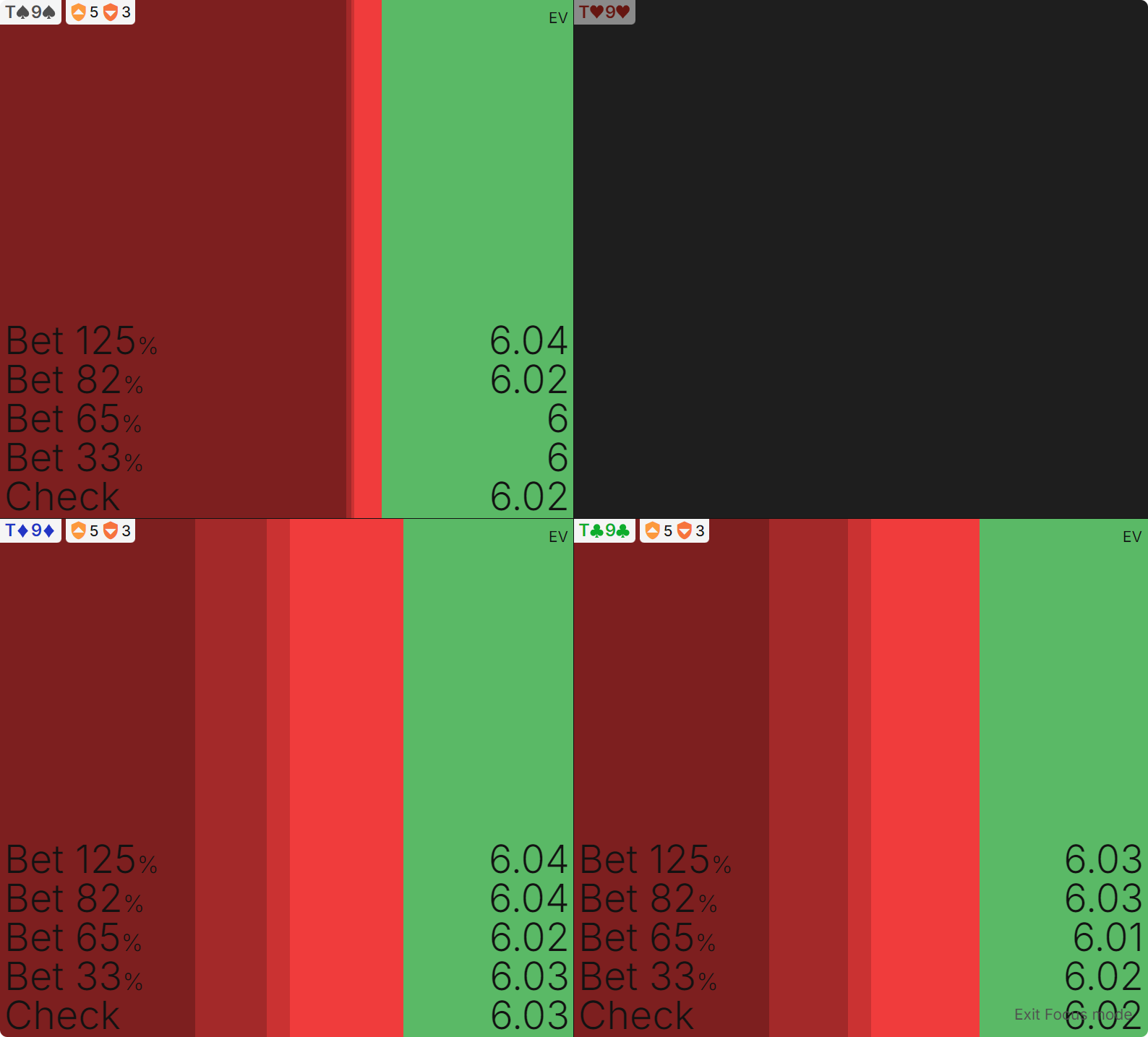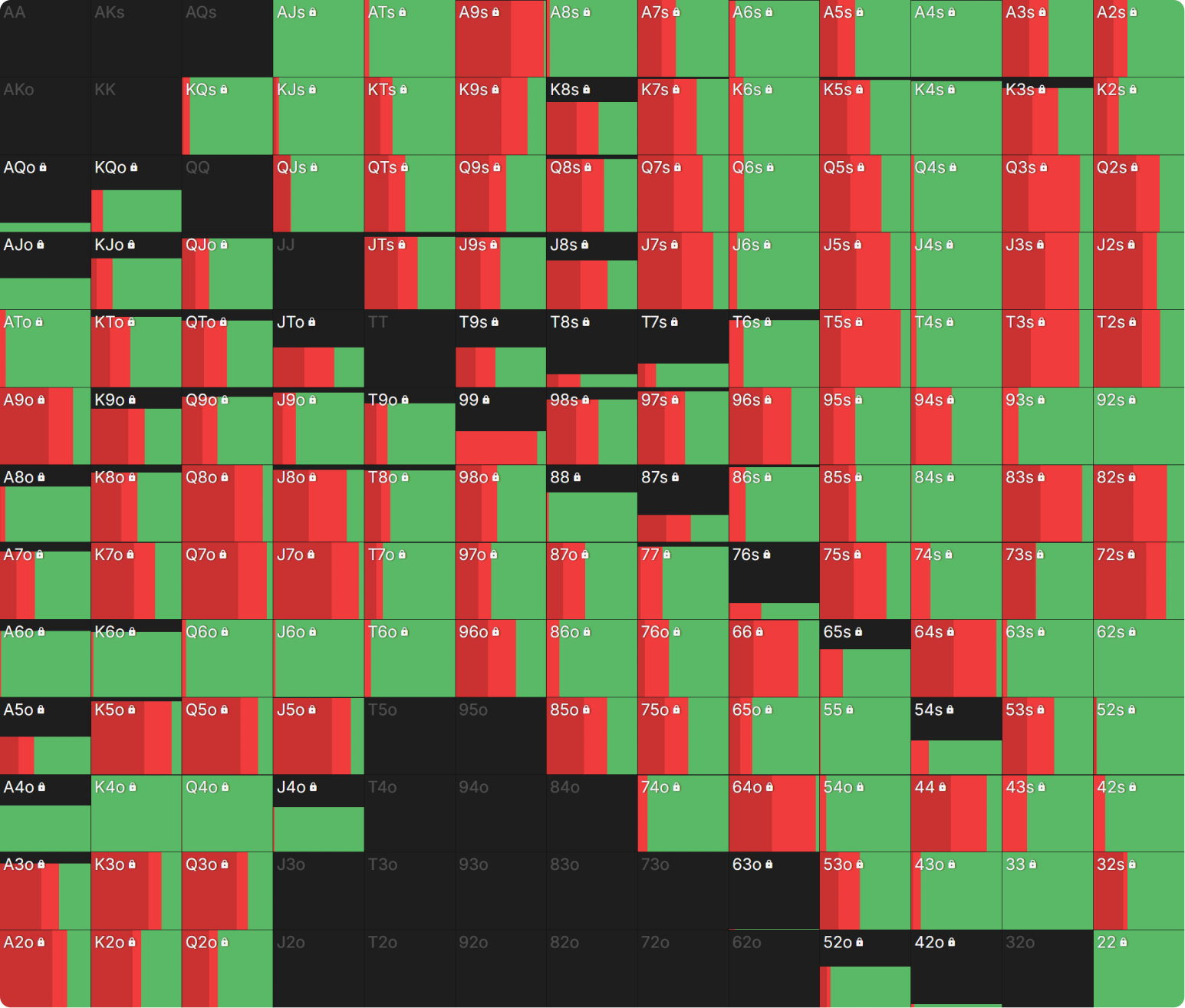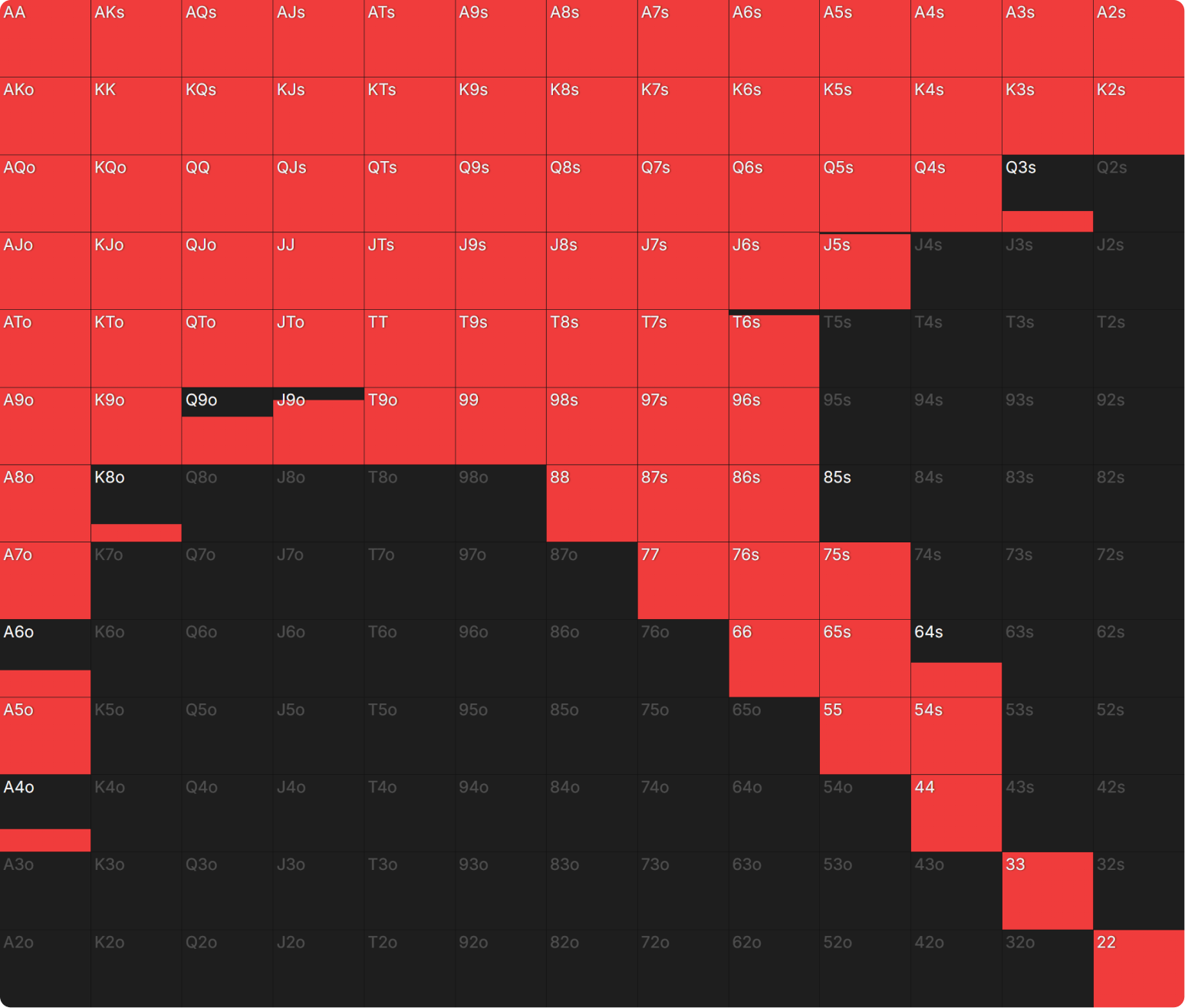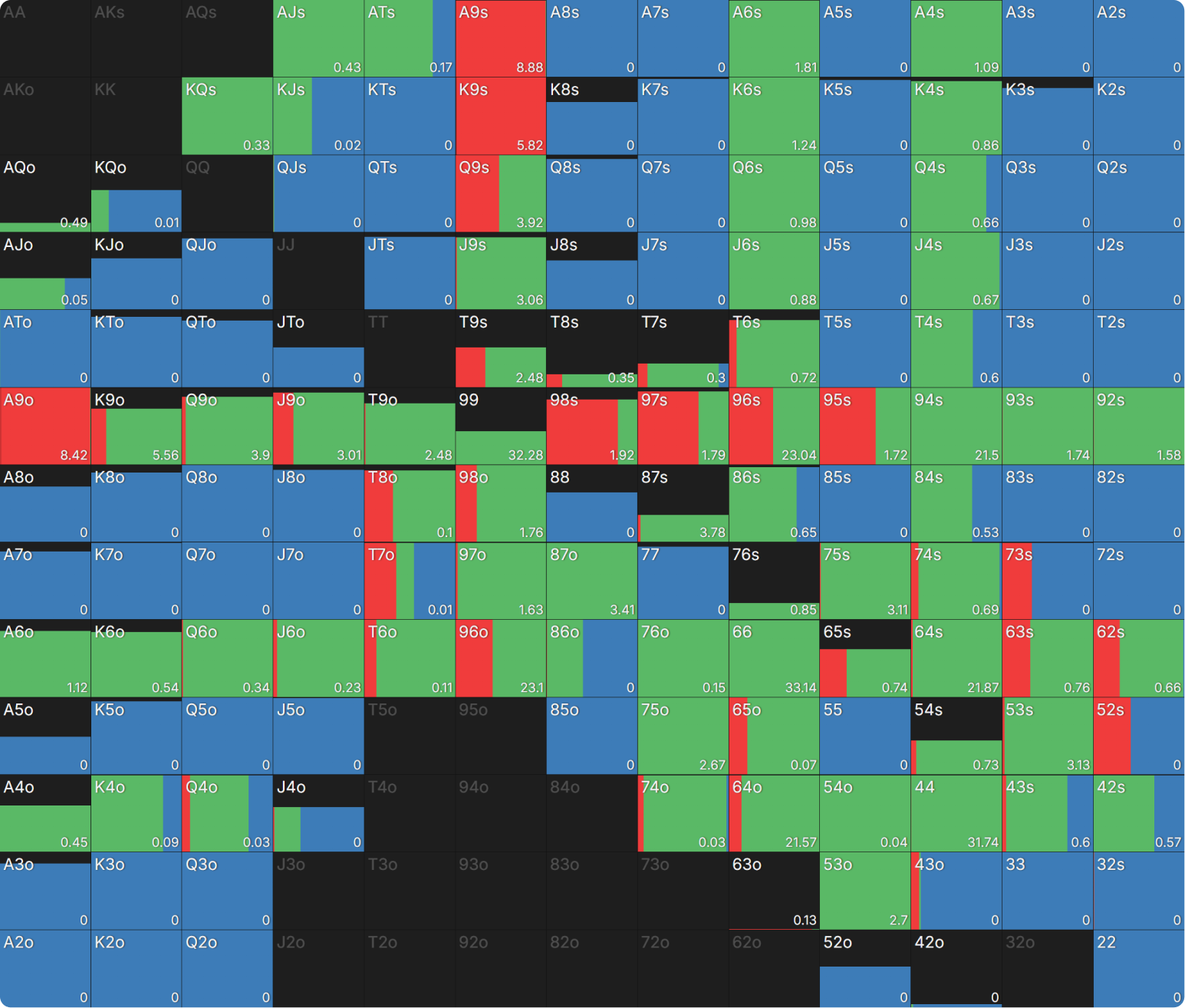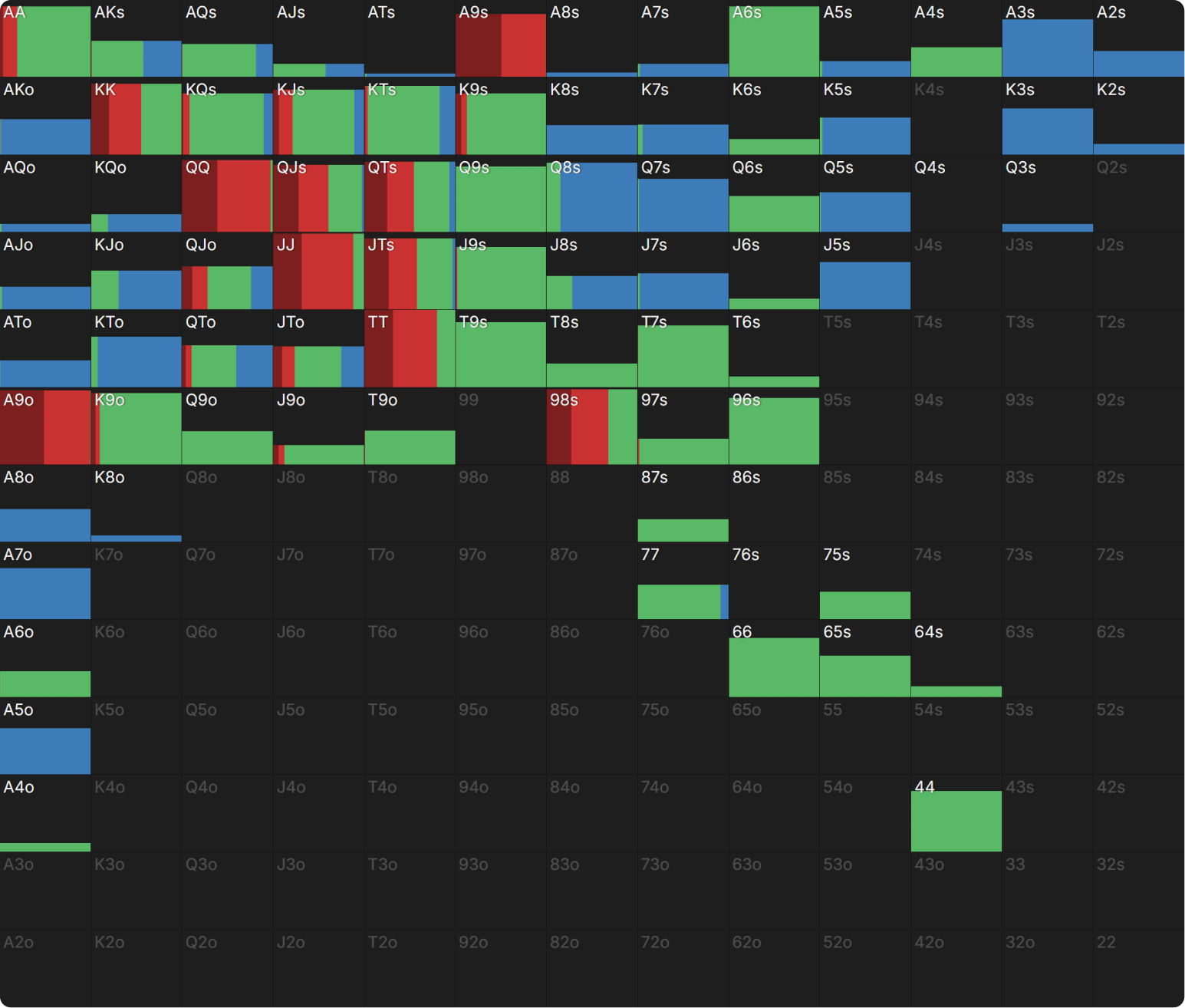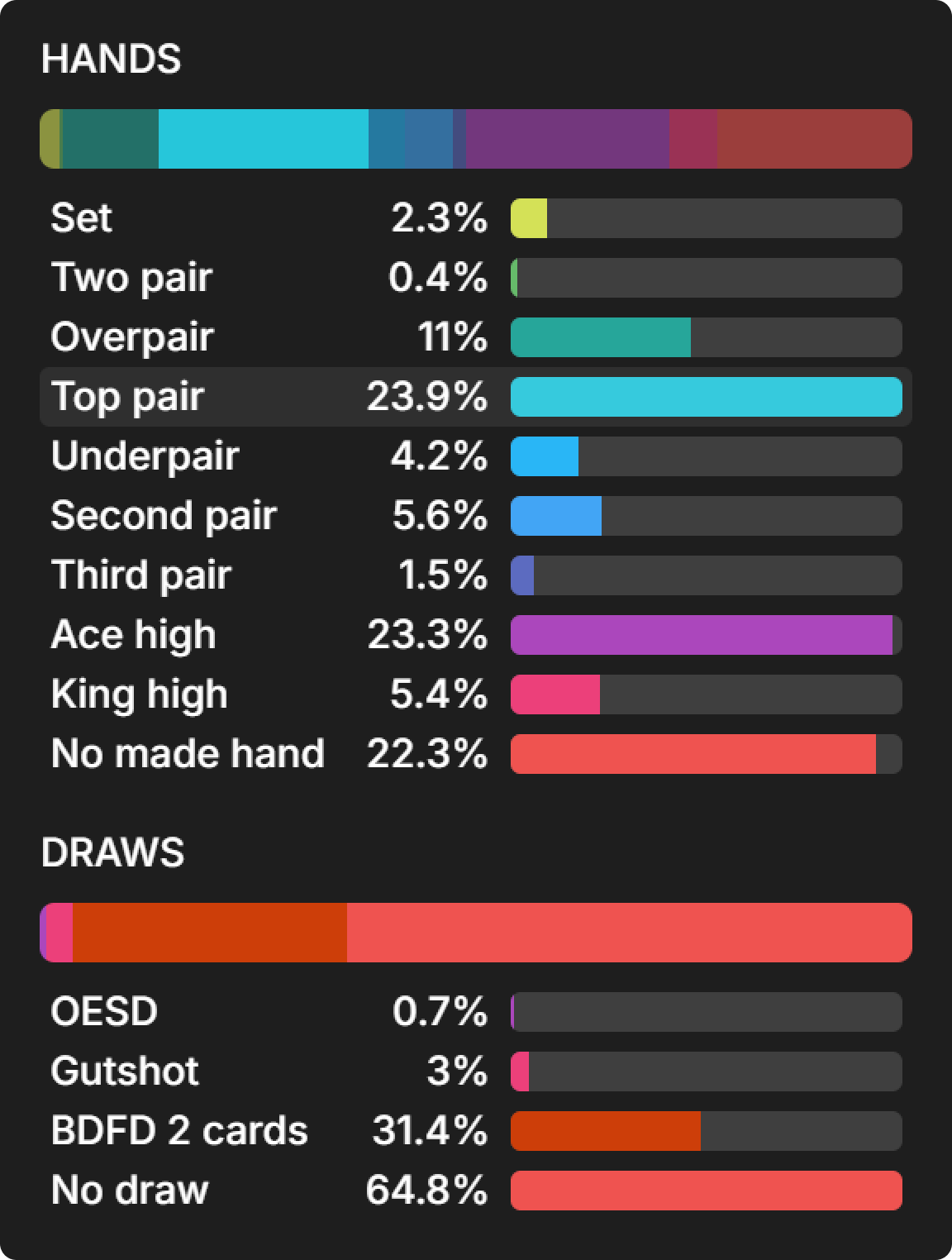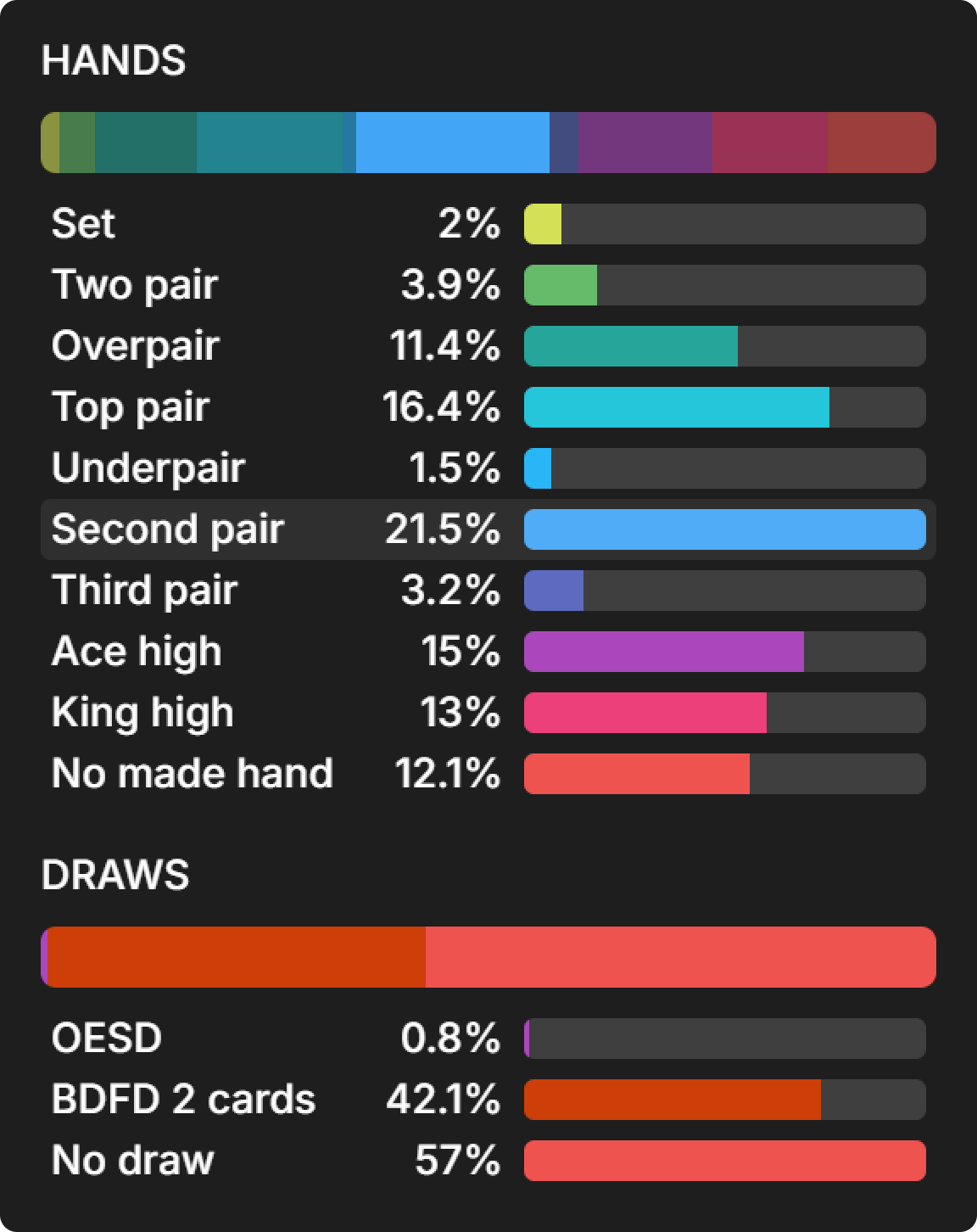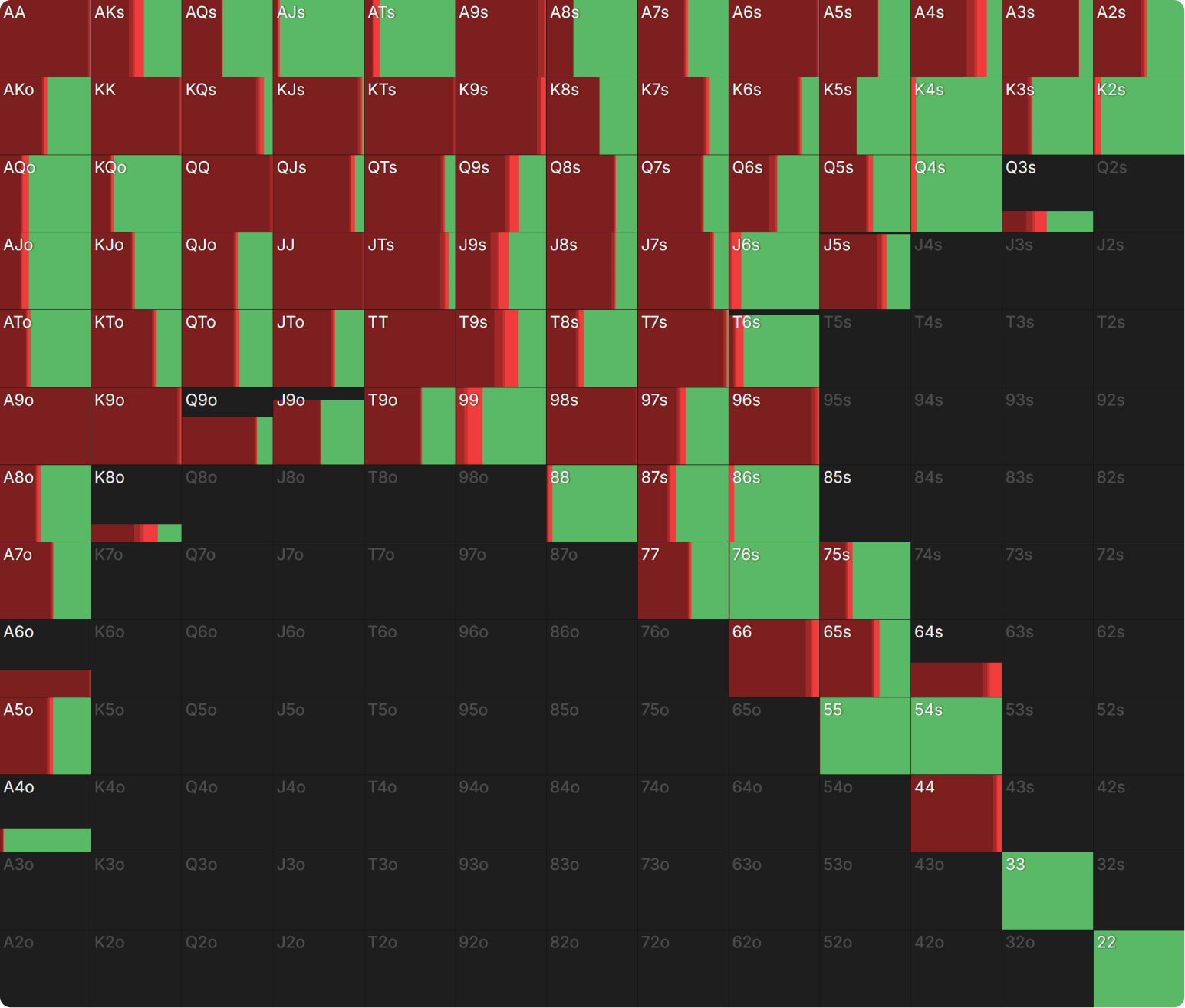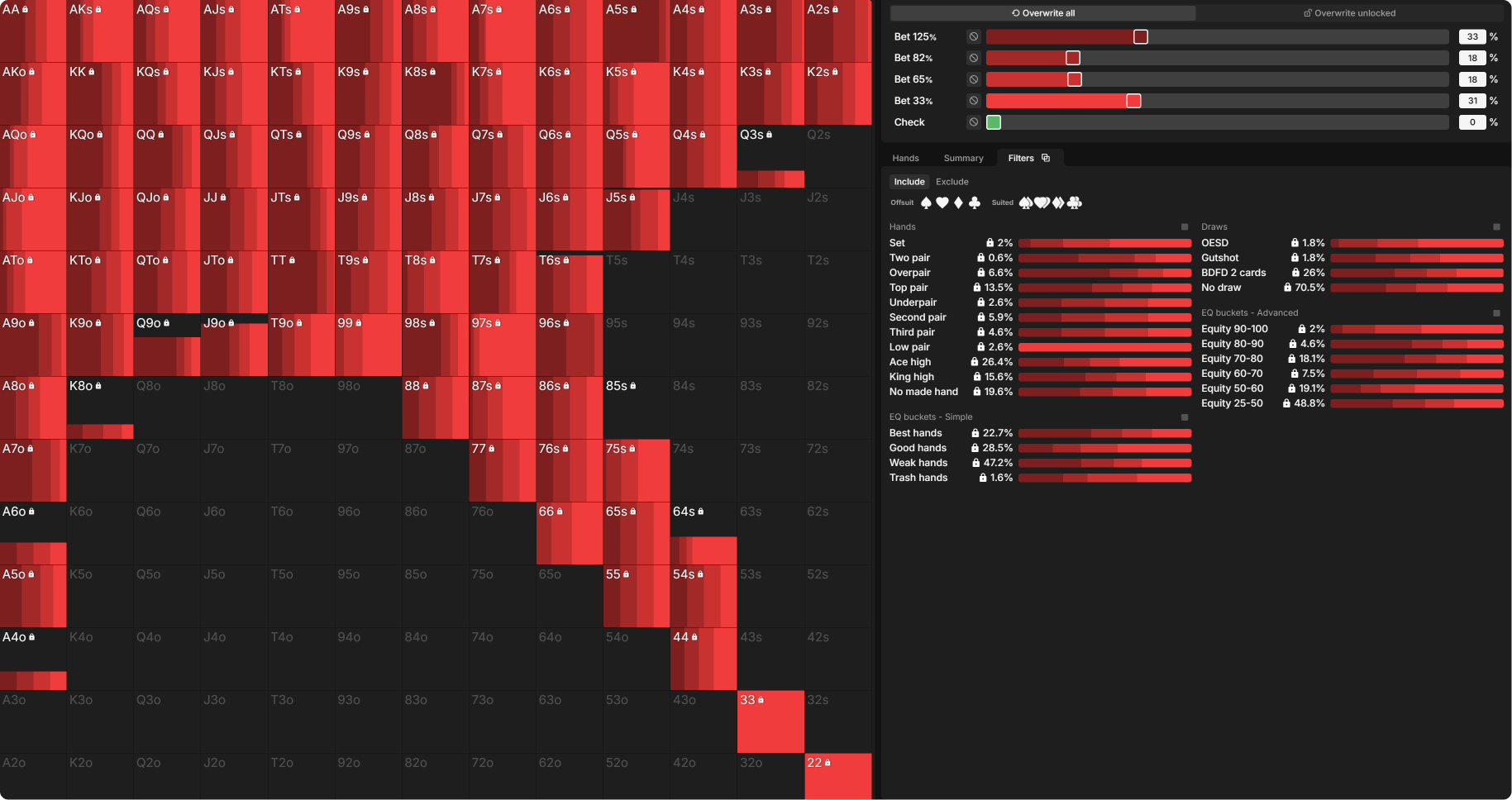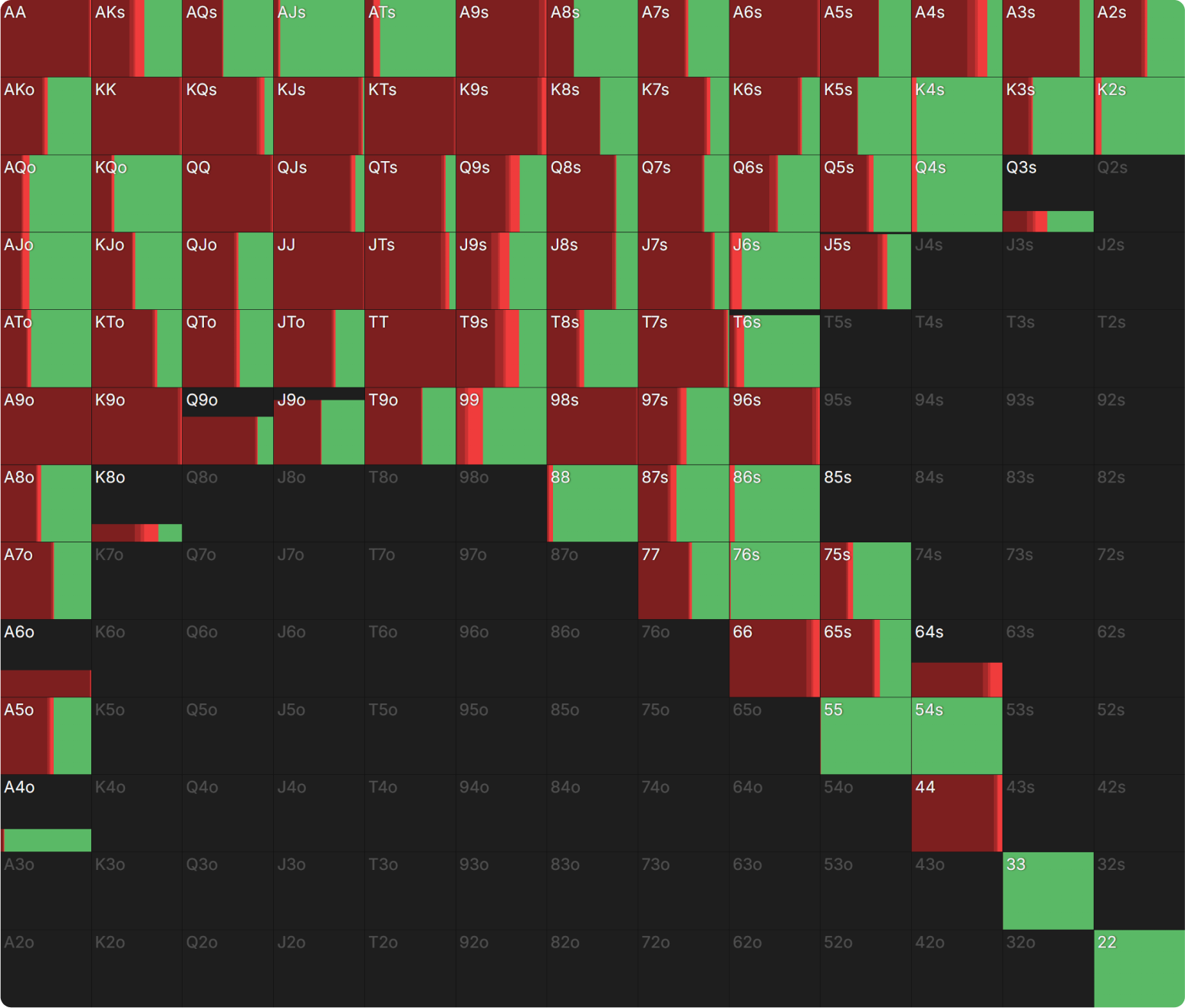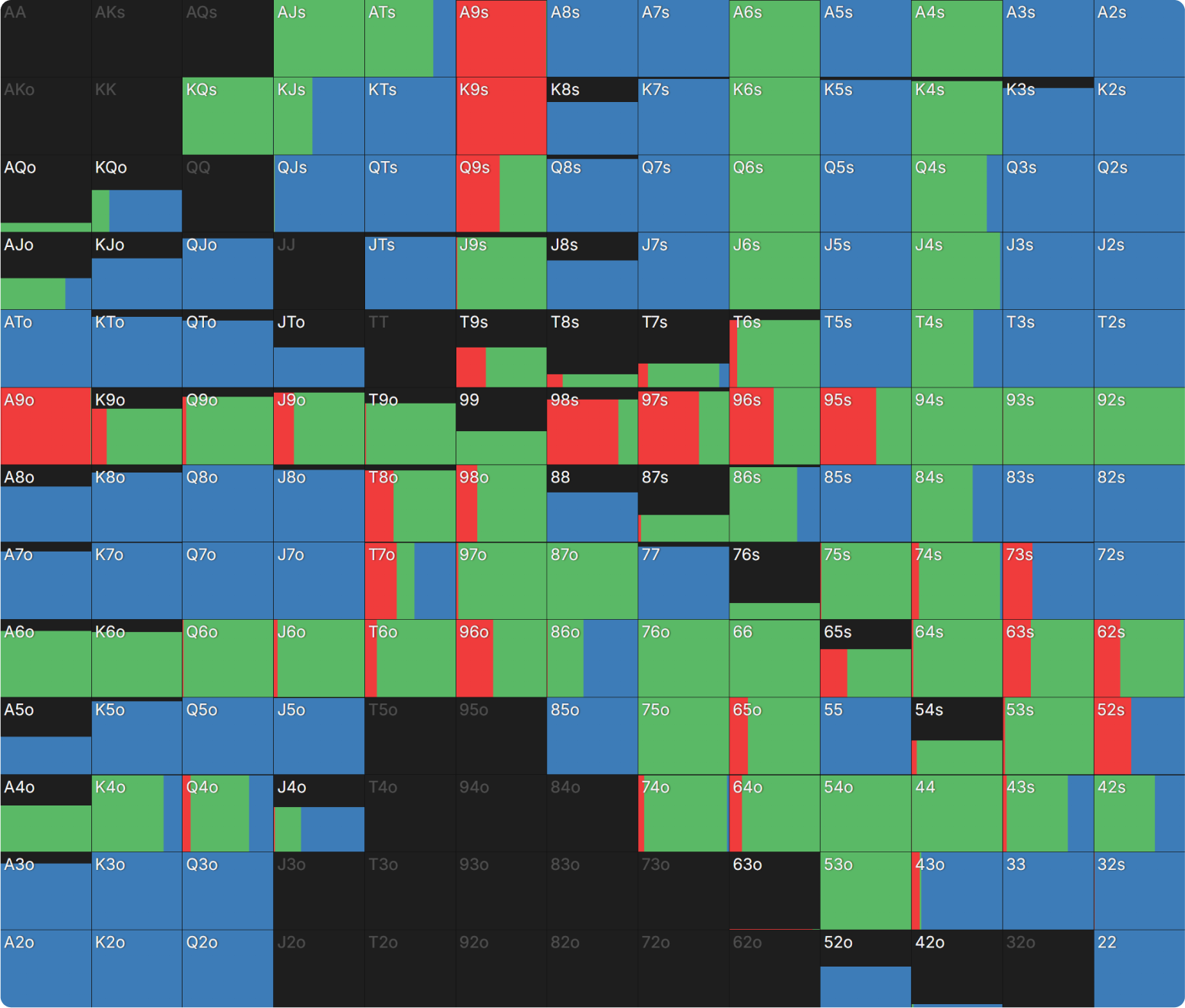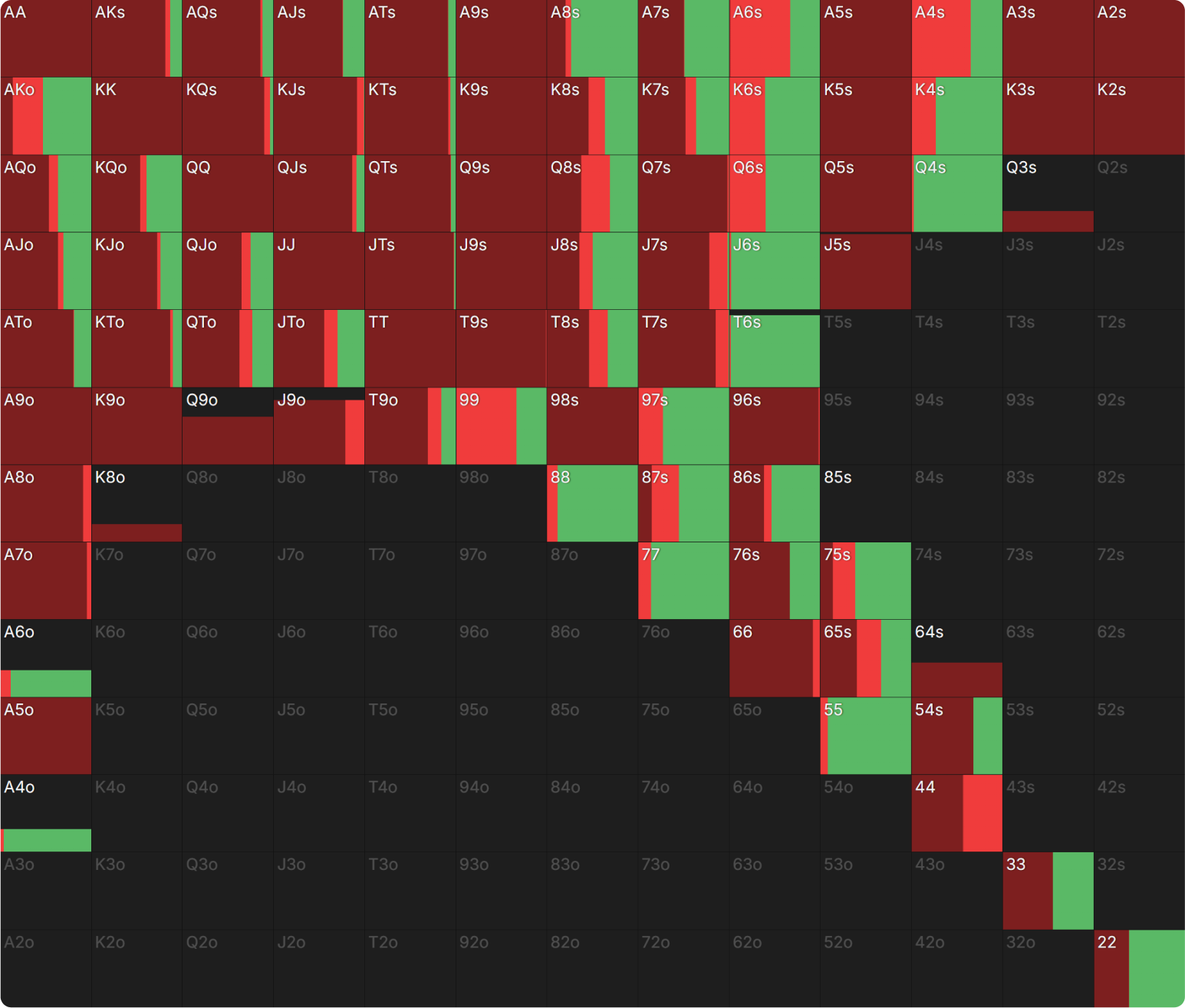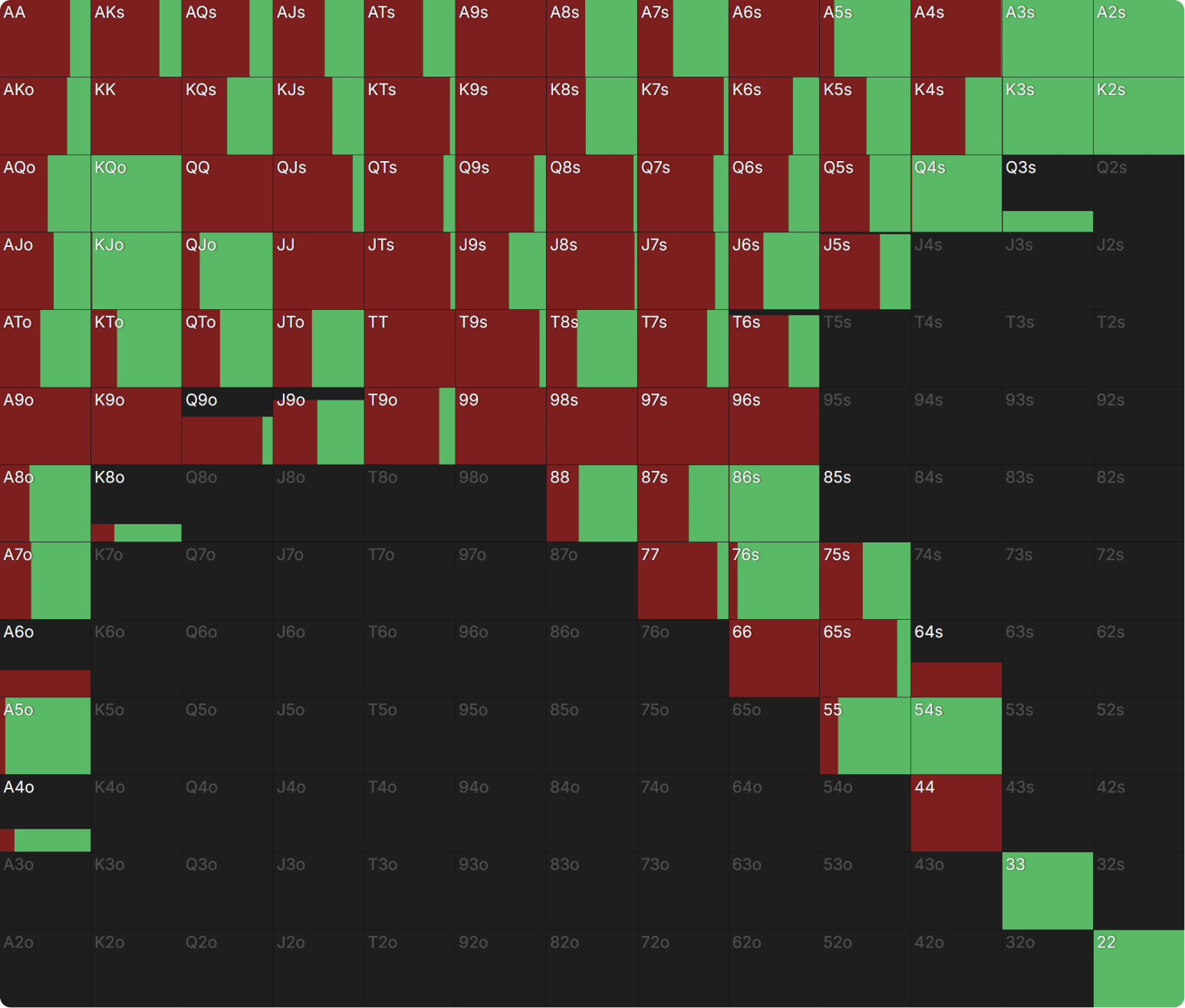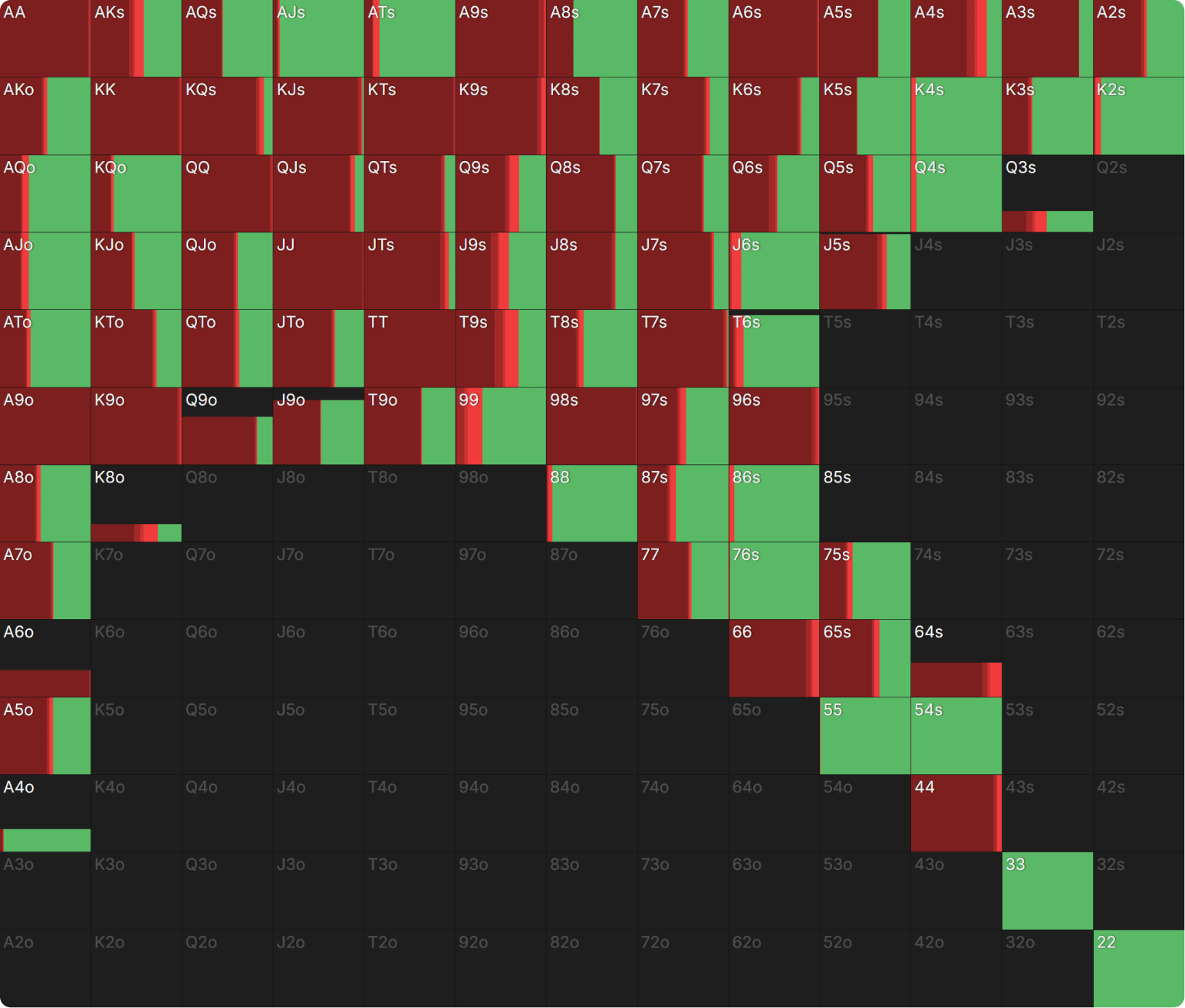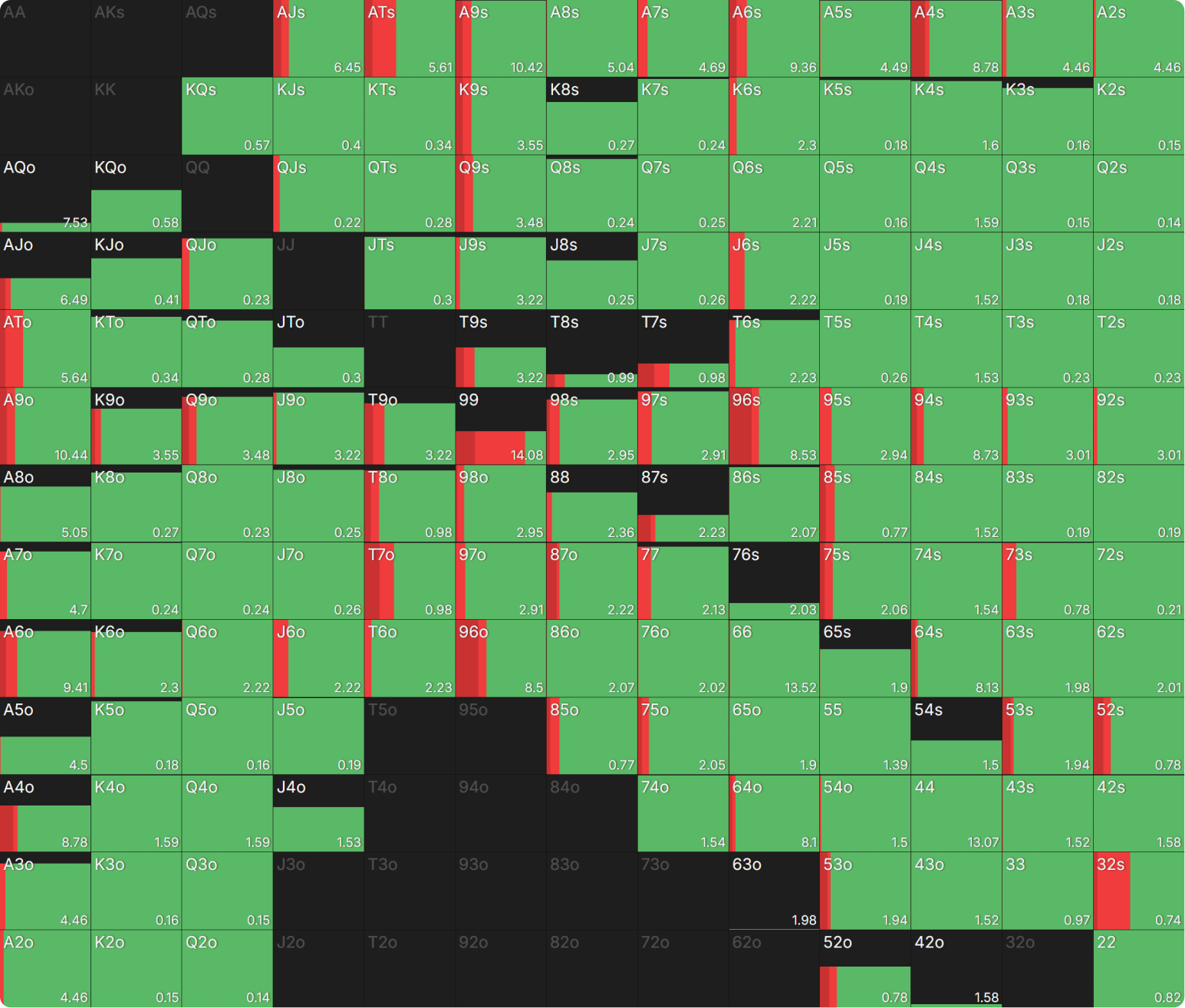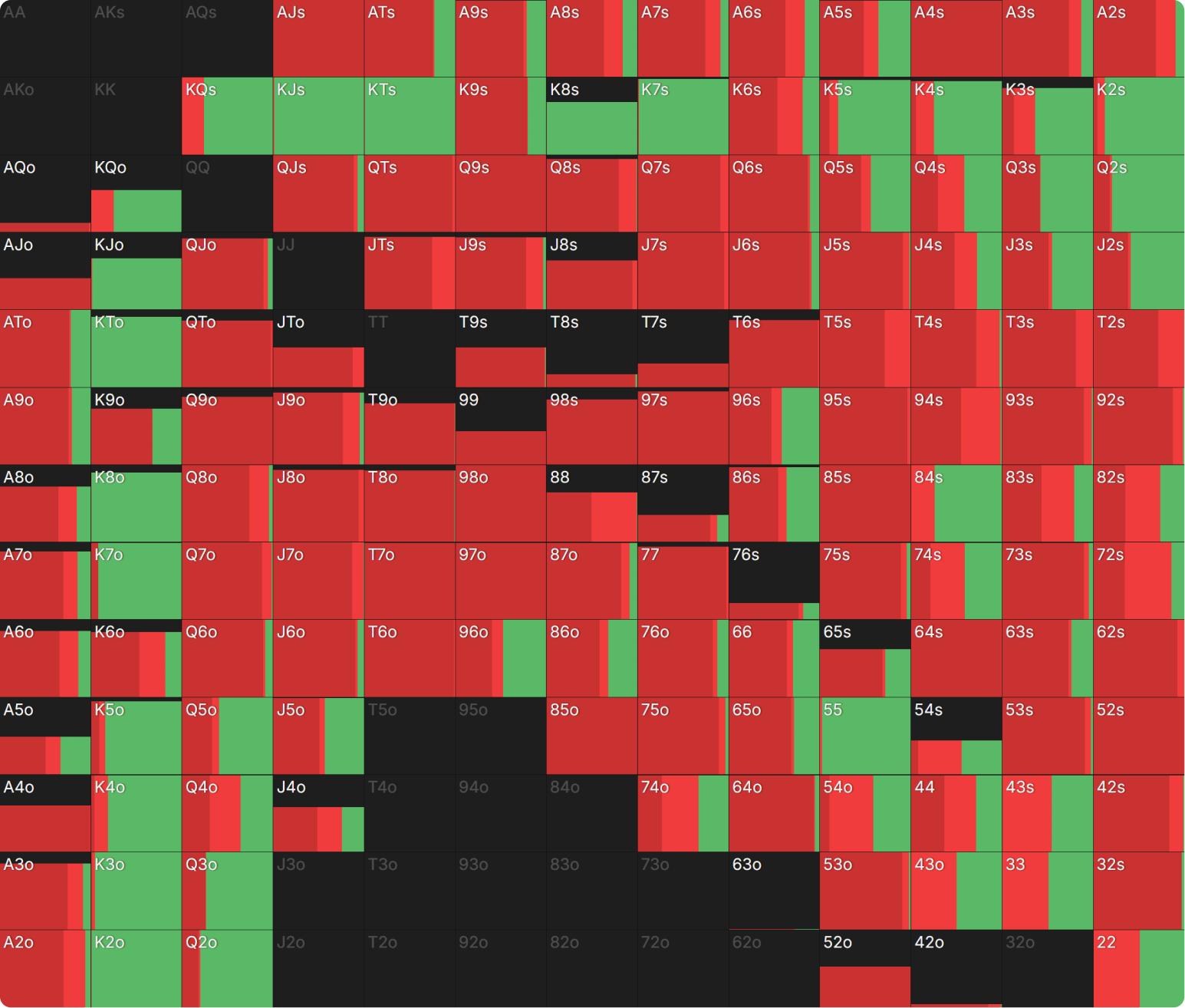The Five Imbalances of Exploitative Poker
One of the great modern debates in poker is GTO vs Exploitative strategy. It can be a surprisingly polarizing discussion, with each strategic methodology having devout adherents who dismiss the other.
In reality, GTO and Exploitative poker are two sides of the same coin.
- Rational exploitative players use GTO as a means to identify leaks and as a baseline strategy to deviate from as an exploit to said leaks.
- GTO strategy, on the flip side, is informed by potential exploits that could be used against it. It develops with the goal of avoiding unnecessary losses.
Exploitative poker is a more offensive, dynamic style that attacks vulnerabilities but does so by exposing vulnerabilities itself. The reason to fight with an open visor is that it allows to inflict greater damage and, therefore, can produce a higher win rate. However, more rewards usually come with more risk! In this case, the potential of counterexploitation. GTO poker is a more defensive, static style in the sense that it’s built around the notion of minimizing leaks as if covered by full-body armor, but the upside is capped. The reward is that it is reliably effective regardless of the opposing strategy. Note that ‘defensive’ does not imply passive. GTO can be very aggressive in its aim to conserve as much EV as possible.
The whole point I’m trying to make is that:
One can not truly understand one style of poker without understanding the other.
Today, we are going to highlight the five fundamental imbalances in poker that inform exploitative strategy. Every leak a player has will fall into one of these categories.
The five fundamental imbalances in poker are:
- Betting Volume – The amount of money that is put into each possible line.
- Equity management – The amount of equity that is put into each possible line.
- Polarity – The extent to which a range is polarized between strong and weak hands.
- Elasticity – How sensitive and adaptive someone is to bet sizing.
- Board coverage – How well someone constructs their range in terms of the interaction with boards and board runouts.
Exploitative poker is about incentives. As we go through this list, think about how these imbalances give you incentives/reasons to lean into certain exploits.
1) Betting Volume
Betting volume refers to:
The aggregate amount of money that is bet in a certain node or series of nodes (line).
Betting Volume = ∑ (Bet Frequency × Bet Sizing)
Exploitative frameworks analyze the opponent’s strategy through the lens of betting volume: where does my opponent put the most money? A betting volume mistake is simply when someone puts too much (or too little) money in on a particular betting (or raising) line. When we categorize a player as a nit, a calling station, or a maniac, we are doing so based on a betting volume error.
Wherever an opponent’s betting volume is highest is where you want to deploy your value, especially your nutted hands. Generally speaking, your nutted hands dictate your strategy, including exploitative strategy:
- Exploit vs over-bluffing – Checking with your value to slow-play or to check/raise.
- Exploit vs over-callers – Betting thinner for value and sizing up with nutted hands.
- Exploit vs over-folders – Sizing down or checking with nutted hands to avoid scaring them away too quickly and thus losing out on value. Bluffing performs better now too, due to the increased fold equity.
Let’s jump into a simple example to make things practical. We are going to use the same hand example for each type of imbalance in this article. This is BB vs CO, single-raised pot, 60bb starting stacks on a flop of 9♥6♦4♣.
The BB checks 100% of the time and this CO’s equilibrium strategy:
There is a mix of checking and betting. The bet sizes mix, but they are mostly overbets or large bets, with only a small amount of 33% pot betting.
The CO’s EV is 3.7bb in GTO World. If we hover over a specific hand (e.g., T9s), these are the EVs of every line:
T9s mostly overbets but mixes all its actions because the EVs of doing so are basically the same.
But what if the BB has a betting volume leak?
We’ll lock the hand so that the BB never folds to the 33% pot bet. This is a player who thinks such a small bet is ‘weak,’ and the person who made it can be outplayed later in the hand. We changed the frequency of folding to zero and let GTO Wizard AI decide how the range calls or raises:
We also locked the 100% check at the start of the hand. You’ll know why if you read our Limits of Nodelocking article. With all that information in mind, let’s see what effect this has on the CO’s c-betting strategy:
The CO has gone from a mixed strategy, which rarely bets small, to betting small 100% of the time. Even very strong hands like sets and overpairs have gone for the small sizing.
Revisiting T9s specifically shows an average EV of ~7.2bb for overbetting, but the average EV of betting 33% pot is even higher at ~8.6bb.
There is a clear betting volume error here! ❌ The BB is putting too much money in against the 33% pot bet line, so the CO is incentivized to use that sizing for their entire range. The no-fold vs bet dynamic allows them to grow the pot they are favored to win on the flop without losing practically any of their advantages on the turn (depending on the new card). Even very weak hands like J5s are beating enough of the BB’s calling range to justify doing this. Bear in mind that this is despite the fact that the BB will pay off overbets. Even the very strong hands that normally are incentivized to overbet, like overpairs and top pair, are choosing the small bet line because they are guaranteed to be called.
At the start of the hand, the CO makes 3.75bb in GTO world, but with the nodelocked strategy, they make 4.71bb overall, which is a significant increase.
2) Equity Management
Equity management in poker refers to:
How a player manages all their possible hands, which come from a varying set of equity buckets.
This topic can be divided into two parts:
- Nut allocation – What do they do with their nutted, high-equity hands?
Do they bet small, do they overbet, or do they check? Do they bluff with their lowest-equity hands or turn made hands into bluffs? - Hand appraisal – How do they value different hand classes?
Some players play top pair the same way others play a set. Some players massively overvalue Ace-x type hands or have a fondness for small suited connectors. There are players who will be quite nitty with top pair, but happy to commit everything with a high-equity draw.
An equity management error would be over- or under-valuing a certain hand class. Classic practical examples of this include over-calling with weak pairs or missing thin value.
Let’s go back to that 9♥6♦4♣ hand. When the CO does overbet, this is the BB’s GTO response:
There is a small (~6%) check/raising range. The value is mostly top pair or two pair, the bluffs are mostly gutshots or backdoor draws. Sets just call, as do the open-ended straight draws.
An equity management error would be over-bluffing in this spot. Let’s nodelock this so that the BB check/raises their open-ended straight draws 100% of the time, and their gutshots or backdoor draws 50% of the time.
They now raise ~23% of the time. If you are following along in GTO Wizard itself, remember to lock the range first. Otherwise the solver will increase the number of hands that check/raise for value to compensate for the imbalance.
Let’s compare how the response changed to optimize against this check/raise, which is now way heavier in semi-bluffs. This is the CO’s original GTO response:
This is how CO reacts in the nodelocked simulation:
In GTO world, the CO should fold ~38% of the time, but in the nodelocked solution, folding is out of the question. They are not incentivized to call either, exclusively raising to exploit the range with too many bluffs in it. Two raise sizes are used, with the shoves being heavier on top pair and the non-all-in raising range skewing toward second pair.
In the GTO example, the CO’s raises are carefully picked. When it is 9-x, it is either A9 or K9, which outkick many pairs of 9-x that call, or T9s/98s/97s, which can all make straights or flushes by the river. The bluffs are broadway overcards like JTs and QTs, which can make runner-runner straights or flushes and also have pair outs against 9-x. In the nodelocked example, we just raise pretty much everything because the BB’s range is too bluff-heavy. This is a recurring theme in exploitative poker strategy:
When your opponent is very out of balance, the need to carefully curate your own range to maintain a delicate balance disappears as well.
Most of the time, you can just do what your hand is incentivized to do.
- At the start of the hand, the CO makes ~3.7bb on average in GTO World.
- In this nodelocked example, they make ~4.5bb on average.
3) Polarity
Polarity in poker refers to:
The degree to which a range is polarized between strong and weak hands or more condensed toward middling hands.
A polarity imbalance essentially refers to not understanding range morphology and using the incorrect strategy for the shapes of the ranges. Is your opponent representing a polarized range with lots of nuts and bluffs or a more merged range with lots of medium-strength hands and draws?
Having a capped range but taking the betting lead would be an example of this imbalance. Betting small with a polarized range or overbetting with a condensed range would be another example.
The exploit for a polarity imbalance depends on the direction of the imbalance:
- If an opponent has a capped or too condensed range, you should attack that range with big sizings because that’s how you extract the most value from such a range.
- If your opponent has a too polarized range, you want to attack them with small bet sizes because polar ranges struggle to call, so a small bet will force them to raise or over-fold.
With the caveat that if they are perfectly polarized (they only have the nuts or a pure bluff) you do not want to attack them. Instead, you should bluff-catch against them because otherwise, they will only continue against you with the nuts.
Once again, looking at that 9♥6♦4♣ hand. A reminder that this is the CO response to a check at equilibrium:
Around 42% of hands check. Some top pair hands check for protection, but mostly, the checking range is made up of lower pairs and Ace-high. A hand like 86s currently has good equity but preserves less of it against the calling range, so it is incentivized to check.
A polarity error here would be for the CO to range-bet with its rather polarized range. This is a common mistake, especially by players from the early days of online who were once able to auto-profit by c-betting every flop purely. This is how the solver adjusts CO’s strategy when we take away the option to check:
In the below node comparison, the BB’s responses to the overbet are contrasted:
The first thing to note is that there is significantly less folding in the nodelocked example. The BB folds ~48% of the time compared to ~58% of the time. The other notable difference is the doubling of the check/raising frequency. This is a common combination of exploits:
When somebody bets too often, you are incentivized to let them make that mistake, and then either bluff-catch wider or pounce with extra check/raises.
At the start of the hand, the BB has a theoretical EV of ~2.1bb. In the nodelocked example, they make ~2.2bb in exploitative EV. Not a huge increase, but magnified over a large sample it is a ~10bb/100 error.
4) Elasticity
Elasticity in poker refers to:
How sensitive and adaptive a player is to bet sizing, aka pricing.
High elasticity means they are very sensitive to pricing, and low elasticity means they are insensitive to pricing.
A satellite winner playing their first ever WSOP Main Event might be too elastic to pricing and over-fold because of fear of busting out. Indeed, every year, amateurs discuss the merits of folding AA preflop in the first level if another player goes all-in. The fear of busting is so great that it trumps the massive +EV proposition of getting $10,000 in the middle as a more than 80% favorite. This is the quintessential ‘scared money’ stereotype.
A wealthy player gambling at stakes that are too low for them is a classic example of a player with a too inelastic leak. These players will call all-ins with any two cards for fun and are immune to bluffing.
You know the drill by now, let’s get out that 9♥6♦4♣ board once more. This was the CO response vs a balanced check from BB:
This is a classic overbetting spot because the CO has a polarized range. They either have a very strong hand relative to this flop (top pair or better) or have missed this flop completely.
This is what the BB should do when the overbet is made:
Plenty of folding, but the BB has to call with hands as weak as Ace-high to avoid being exploited.
What if, however, the BB is over-sensitive to pricing and would never call an overbet with second pair or lower?
This is what the CO does when checked to on the flop when we lock in the above leak:
The CO has gone from betting ~58% of the time to betting ~76% of the time. They have also stopped using the 82% bet size altogether. Their overbetting frequency jumped up from 52% to 66% of the time.
With BB being over-sensitive to pricing, expressed as over-folding to overbets, CO is incentivized to increase the frequency of overbets.
A more curious adjustment is that the 33% bet size also sees an increase in frequency (from 3% to 9%). This is because some hands in the range really do not want the BB to over-fold. In particular, the sets adopt this strategy when they overbet a lot of the time at equilibrium. 99, for example, makes around 14.5bb whether it is checked, small bet, or overbet in the unlocked GTO solution. In this nodelocked example, it only makes ~10.5bb as an overbet but ~13.8bb as a small bet.
Let’s switch gears and observe what happens when we model the BB as price-insensitive by having them call any pair and Ace-high too.
This is a gambler that over-calls to overbets. Given the assumed elasticity error, this is how the CO plays after they check flop:
The frequency of betting has not significantly changed from the GTO example, but now the betting range is exclusively overbet. If Villain is not folding to the biggest bet size, we may as well use that size with all our value.
- In the GTO example, at the start of the hand, the BB made ~2.1bb on average.
- In both nodelocked examples, they made ~1.85bb in the price-sensitive example and ~1.8bb in the price-insensitive example.
5) Board Coverage
Board coverage in poker refers to
The ability to make strong hands across a wide range of possible board textures.
Balanced ranges have board coverage, meaning they can potentially hit any flop. Most opening ranges contain most of the suited Ace-x hands, such as A3s, because they are an economical way to achieve board coverage. A tight opening range can still hit a 3♥2♦3♦ flop because it was constructed with board coverage in mind.
Board coverage isn’t limited to the flop; it also has an aspect of runout coverage. An easy-to-digest example is when there is a potential flush draw on the flop. We want to have flush draws both when we check and when we bet, so when the turn brings a flush-completing card, we can represent it in both scenarios.
A board coverage error is made when a line is over- or under-saturated with certain types of hands. When a player never c-bets with Ace-high on the flop, they should generate fewer folds when they barrel on a turned Ace. When a player never checks back a pair, they can more easily be pushed off a hand when the turn pairs the board.
Oh look who it is, it’s that 9♥6♦4♣ hand from earlier. In the unlikely case you forgot, here’s a reminder of the GTO flop strategy for the CO when checked to:
Let’s say the flop goes check-check, and the turn is an A♠. This is the first action from the BB:
There is a small amount of leading because the CO has weakened their range by checking, but most of the time, the BB checks again.
What if we updated the CO’s c-bet strategy so that they always bluffed with Ace-high, at a variety of sizings?
When the flop checks through now and the A♠ turn comes, the BB’s adjustment looks as follows:
The BB has gone from leading 6% of the time to leading 70% of the time. Why?
By betting all of their Ace-x on the flop, the checking CO has a capped turn-range when the Ace shows on fourth street. In the GTO example, the CO checked a lot of Ace-x hands on the flop, which gave them runout coverage for an Ace coming on the turn. However, in this example, the BB knows the CO cannot have top pair, so they punish them by betting a lot.
The issues caused by a board coverage error manifest when the under-represented board card is dealt. In the example above, when the Ace turns up, the CO is unable to represent that card, so much so that the BB can attack with leads around 70% of the time. Alternatively, the CO loses the implied odds when they hit the Ace on the turn when the flop goes check-bet-call, because now they have too many Ace-x hands, and will not get paid off.
This is why we mix our actions, so we can represent value (and bluffs) on every possible runout in every possible line.
Board coverage imbalances give attentive players a form of clairvoyance that allows them to tell when a card has (or has not) improved their opponent.
- In GTO world, on the turn, the CO makes ~3.8bb on average.
- In the nodelocked example, their expected value drops to ~2.4bb.
Conclusion
This is a starting guide to exploitative poker. Any leak you notice at the table, every play that deviates from GTO, will have one of these imbalances. Of course, it could be the case that a player has multiple imbalances at the same time. A tight player may under-bluff (see equity management) and not have any low suited Ace-x hands like A3s (see board coverage). A loose player might always c-bet every board, even the ones where they have a polarized range (see polarity) and never fold to reraises (see (in)elasticity).
The nodelocking feature of GTO Wizard AI will show you how to adapt to these players. It can also show you what the EV is of a line in a GTO context compared to playing against the specific suboptimal opponent that you modeled. The severity of an error is really worth paying attention to, as we have seen above, some errors are more costly than others.
If you found this topic interesting, Tombos21 covered it in more depth and explored more themes in the following video:
Article written by Barry Carter, exploring the themes presented in Tombos21’s video.
Author
Barry Carter
Barry Carter has been a poker writer for 16 years. He is the co-author of six poker books, including The Mental Game of Poker, Endgame Poker Strategy: The ICM Book, and GTO Poker Simplified.
Wizards, you don’t want to miss out on ‘Daily Dose of GTO,’ it’s the most valuable freeroll of the year!
We Are Hiring
We are looking for remarkable individuals to join us in our quest to build the next-generation poker training ecosystem. If you are passionate, dedicated, and driven to excel, we want to hear from you. Join us in redefining how poker is being studied.

